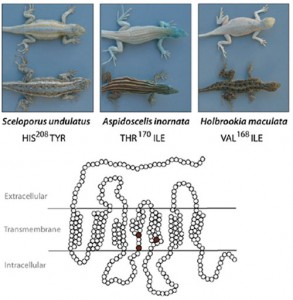Energizing Evolution
it, as well as our understanding of it, just keeps going and growing and going…
During the holiday break, I have come across a number of valuable resources (video, audio, and paper) for demonstrating to students that the processes of natural selection and speciation, that Darwin made us aware of 150 years ago this past year, are actually occuring before our very eyes.
Instead of hypothetical just-so-stories, these resources are user friendly and thought provoking real world examples with organisms and adaptations that students can relate to. These examples also highlight the work of the people, and the personalities, behind the acquisition of new scientific knowledge. I commend these scientists and numerous others who understand the importance of communicating science to a sometimes skeptical public and whose efforts have provided us with these wonderful resources and springboards for learning.
Read on to find out about these 7 resources…
- What Darwin Never Knew
This is a new 2-hour Nova video that was broadcast on December 29th. I must admit that I didn’t know of the broadcast but once I happened upon this new resource while flipping channels, I stopped and was mesmorized by the show. The segments I saw appeared to be a video compliation of Sean Carroll’s Making of the Fittest and other similar recent research. - The Aquatic Hypothesis for our Hairlessness
This is a 17 minute TED Conference lecture by Elaine Morgan an avid supporter, as you will see and hear, of the aquatic hypothesis for the evolution of our hairlessness. I had heard of this hypothesis but never knew much about its supporting evidence. This is a good introductory lecture on the topic of our nakeness. - Bird Feeders Speed Up Evoltion, May Split Species
This is a 12 minute audio segment on the “Reporting in Current Biology, researchers write of a warbler that has quickly evolved an unorthodox migration path to England to take advantage of backyard bird feeders. Study author Martin Schaefer explains how the clever migrants could become a distinct warbler species.” - Of Fish and Flies: The Evolutionary Role of Genes
This is a 4 minute audio segment of the on genes involved in the divergence phenotypes of stream and pond sticklebacks and fruit fly wing pigmentation discovered by David Kingsley at Stanford and Sean Carroll at the University of Wisconsin, respectively. I believe that this radio segment may have been inspired by the NOVA video mentioned above. - Kinkiness Beyong Kinky
This is a blog post on Discover’s website by Carl Zimmer who reports on the interesting coevolution of male and female reproductive anatomy in ducks. Videos are included. - Radiations & Extinctions: Biodiversity through the Ages
This is a full chapter excerpt from the latest book by Carl Zimmer, The Tangled Bank provided by the National Center for Science Education. If you end up enjoying the read, use the this link to surf to amazon to make the purchase. - Convergent Evolution and Divergent Selection: Lizards at the White Sands Ecotone
While reading the year end review in the most recent issue of the journal Science, I came across this example of natural selection in three species of lizards at White Sands National Park in New Mexico (see this blog posts accompanying image). This research conducted by Erica Bree Rosenblum at UC Berkeley helps to bring the ecosystems, organismal, molecular, and genetic prespectives in an easy to relate to manner. The title link will take you to a pdf copy of the original paper published in the American Naturalist (2006 isn’t really that recent), while the two links that follow are to a more student friendly magazine article and blog post on the research.
http://www.nps.gov/whsa/naturescience/upload/Rosenblum%20-%20lizards.pdf
http://scienceblogs.com/notrocketscience/2009/12/three_desert_lizards_evolve_white_skins_through_different_mu.php
Happy New Year! I hope you enjoy the links, and look for a post on iPhone apps for Biology Teachers in the near future.

